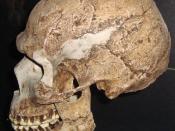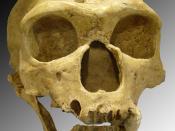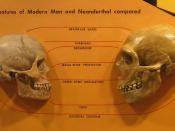It's complete... the real version has pictures Well done.
'Human Evolution and the Fossil Record.'
Scientists continue to debate the history of man. It is generally agreed upon by the scientific community, however, that humans evolved from lesser beings, and this essay will function to provide evidence to support this claim. Several points will be outlined, including the general physical changes that occurred between several key species on the phylogeny of man, and a discussion of dating methods used to pinpoint the age of the fossils.
This essay will begin with a brief discussion of dating techniques. In the study of hominid evolution, two main methods of dating are used: carbon-14 and potassium-argon dating. Carbon-14 dating involves the decay of radioactive C-14, which has a half life of 5770 years. This makes this method useful for dating of recent fossils, with good accuracy, up to 50,000 years back. After 5770 years, half of the carbon-14 in a fossil decays to nitrogen-14.
Since the ratio of carbon-12 to carbon-14 in a living organism remains the same as in the environment around them because the organism constantly eats and replenishes it, if it were to die, the ratio would change greatly after many years. It is the difference between this ratio now and the time is died that allows a date for it to be established. Potassium-argon dating, another dating method, is possible due to volcanic ash and rocks found near many fossil sites. Rocks and ash created in this manner contain potassium-40, but no argon. As time passes, the potassium-40 decays into argon-40. In the laboratory, the sample is reheated, and since argon-40 is a gas, it is released. The ratio of argon-40 released to potassium-40 still present allows for a date to be assigned to objects near the sample. However,


